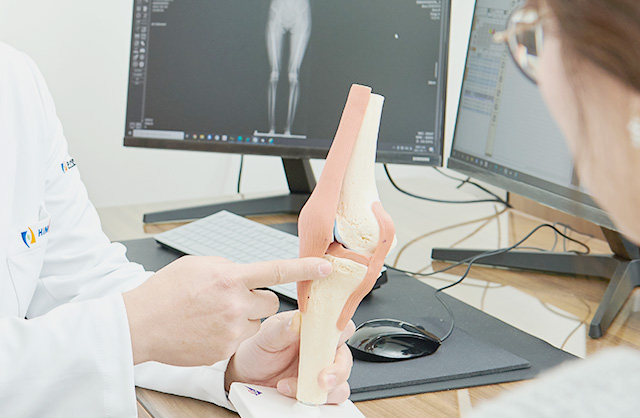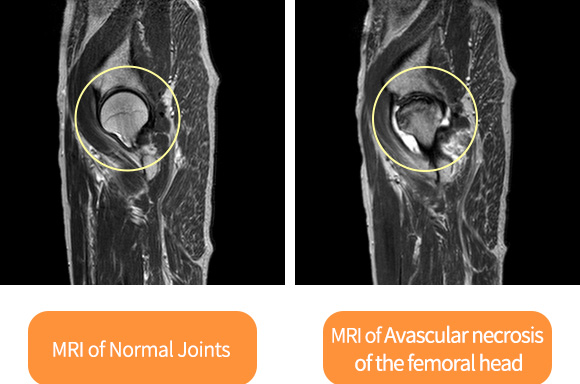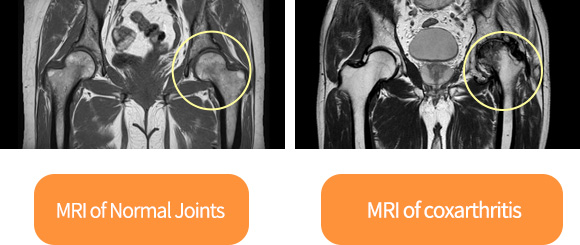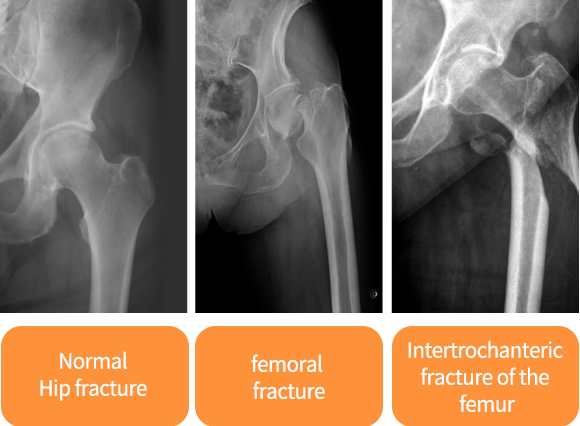
Medical Information
Orthopedic Surgery
- Orthopedic Surgery
- Neurosurgery
- General Surgery
- Pediatrics and Adolescents
- Emergency Medicine
- Kidney Medicine
- Cardiology
- Endocrinology
- Respiratory Medicine
- Gastroenterology
- Family Medicine
- Neurology
- Gynecology
- Dental Clinic
- Anesthesiology and Pain Medicine
- Occupational Environmental Medicine
- Radiology
- Diagnostic Laboratory Medicine
Orthopedic Surgery
Avascular necrosis of the femoral head
The femoral head is the tip of the thigh bone. It is ball-shaped and meshes with the pelvis to form the hip joint. When bone tissues die as the blood supply to the femoral head is blocked for some reason, it is called avascular necrosis. It is a common hip joint disease that accounts for the majority of hip joint diseases.

Treatment of avascular necrosis of the femoral head
-
Non-surgical treatment
If the size of the necrosis is small and it is not serious, medication treatment is applied first followed by observing the effect.
-
Surgical treatment
If avascular necrosis of the femoral head has already occurred, the best treatment is surgery. If detected at an early stage, it can be treated with bone grafts or rotational osteotomy as well as decompression surgery to help blood circulation with a hole in the femoral head.
Central decompression surgery
It is a method to reduce pressure in the bone by drilling one or several holes in the femoral head and to supply nutrients to the hip joint, helping create new blood vessels. It can be expected to be effective in preventing the collapse of the femoral head or the progression of arthritis.Artificial Hip Surgery
It is to replace damaged cartilage and bone with an artificial hip joint. It provides an effective treatment to patients along with pain relief and 90-95% of functional recovery.
Degenerative arthritis of the hip joint
As the hip joint bears as much weight as the knee, degenerative changes can appear. If you are not able to walk well with pain in your hip and groin as you are aging, it can be either avascular necrosis of the femoral head or degenerative arthritis of the hip joint.

Treatment of degenerative arthritis of the hip
-
Conservative Treatment
In the early stage, doctors apply anti-inflammatory agent, exercise therapy, or injection therapy. The effect of conservative treatment is to reduce pain caused by degenerative changes in the joint cartilage, to keep the joint functioning and to prevent it from being deformed.
-
Surgical Treatment
Depending on the degree of damage to the hip joint, the surgery can be different. In the early stage, a surgeon can help relieve pain by trimming the damaged cartilage through arthroscopy.
Pelvic Osteotomy
Osteotomy changes the position of femoral head or acetabulum to help expand the weight bearing area or relocates a weight bearing surface to the relatively healthy joint cartilage so that pain can be alleviated, deformation corrected, and progression of degenerative changes prevented or slowed down.Hip Arthroplasty
The artificial hip joint consists of a femur (stem) that is placed like a column in the femur and an acetabular cup (cup) that is placed into the pelvis (acetabulum). Both the stem and cup are made of metal. Between the stem column and cup is a joint surface made, which is a plastic, ceramic or metal spacer. A long lifespan can be expected thanks to the development of the joint surface and surgical techniques.
Hip fracture
The hip joint is a strong and stable structure and does not break easily. However, as bones become weak with age and osteoporosis develops, it can be easily broken even by a light impact. When the hip joint is fractured, you cannot move with extreme pain, and surgery is required regardless of age.

Treatment of hip fractures
If the hip joint is fractured, fracture fixation can be considered first. Fracture fixation is to connect broken bones with an iron core made of special metal. It takes time for the bone to completely be attached, but it will eventually return to normal after recovered from the surgery.
-
Femoral neck fracture
If the neck of the femur is broken, several screws are inserted to fix it or artificial hip arthroplasty is performed.
-
Intertrochanteric fracture of the femur
If the bone breaks into several pieces in the line connecting the two upper protrusions of the thigh, a surgeon fixes the fractured bones with a metal screw.
* In rare cases, bleeding, infection, and blood clots may occur during surgery.


